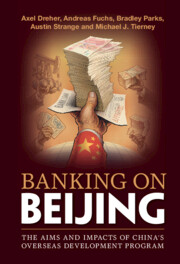Book contents
- Banking on Beijing
- Banking on Beijing
- Copyright page
- Contents
- Figures
- Tables
- Acknowledgments
- Abbreviations
- 1 Why Do We Know So Little about the Aims and Impacts of China’s Overseas Development Program?
- 2 The Journey to Global Creditor
- 3 Counting and Comparing Apples and Dragon Fruits
- 4 Follow the Money
- 5 Apples and Dragon Fruits
- 6 Aid à la Carte
- 7 Paving the Way to Growth and Development?
- 8 Poisonous Dragon Fruits?
- 9 Banking on the Belt and Road
- Postscript: Analysis of China’s Overseas Development Program During the BRI Era With an Updated Dataset
- References
- Index
7 - Paving the Way to Growth and Development?
The Socioeconomic Impacts of Chinese Development Projects
Published online by Cambridge University Press: 21 April 2022
- Banking on Beijing
- Banking on Beijing
- Copyright page
- Contents
- Figures
- Tables
- Acknowledgments
- Abbreviations
- 1 Why Do We Know So Little about the Aims and Impacts of China’s Overseas Development Program?
- 2 The Journey to Global Creditor
- 3 Counting and Comparing Apples and Dragon Fruits
- 4 Follow the Money
- 5 Apples and Dragon Fruits
- 6 Aid à la Carte
- 7 Paving the Way to Growth and Development?
- 8 Poisonous Dragon Fruits?
- 9 Banking on the Belt and Road
- Postscript: Analysis of China’s Overseas Development Program During the BRI Era With an Updated Dataset
- References
- Index
Summary
This chapter examines the effectiveness of Chinese development finance. At the recipient-country level, we test the impact of Chinese development finance on economic growth, infant mortality, and the spatial concentration of economic activity. We then move below the country level and investigate the economic development effects of China’s development finance at the subnational level using luminosity data at fine spatial resolution (in addition to infant mortality and spatial concentration). We disentangle differences between Chinese aid and debt and compare these effects to those of World Bank funding. In addition, this chapter analyzes whether the motivational forces that shape the provision of Chinese development finance affect downstream development outcomes in recipient countries and regions. The empirical evidence presented in the chapter shows that, irrespective of political bias, Chinese aid and debt improve socio- economic outcomes at both national and subnational scales. However, these impacts vary significantly across jurisdictions. We also find that socio-economic impacts of Chinese development projects are comparable, if not superior, to those generated by the World Bank.
- Type
- Chapter
- Information
- Banking on BeijingThe Aims and Impacts of China's Overseas Development Program, pp. 192 - 246Publisher: Cambridge University PressPrint publication year: 2022

